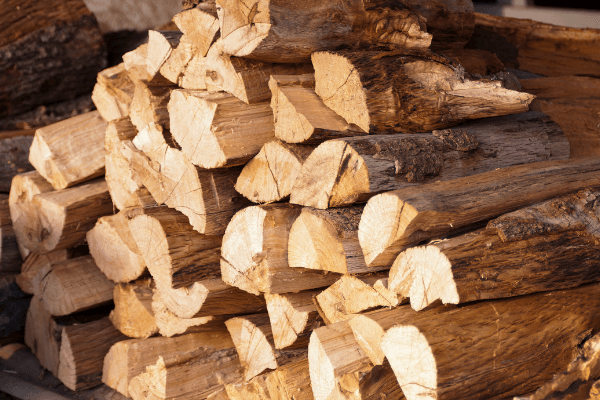- Home
- Storing Firewood
- How to Season Firewood
How To Season Firewood
This post may contain affiliate links so I earn a commission.
Want to learn how to season firewood?
Good news.....it's really not that difficult if you follow a few basic guidelines.
Firewood can be a great alternative heating source to lower your monthly utility bill.
In fact, many people (including myself) have completely eliminated their monthly heating bill by burning firewood.
As fuel prices rise, the cost of heating a home can be a strain on your budget.

To help save money and keep your home warm, burning firewood could be an option.
Before you run out and cut down a tree it's important to understand the difference between dry, seasoned firewood and wet, unseasoned firewood.
Seasoning firewood takes time.
Dry firewood burns hotter, easier and safer than wet wood.
Unseasoned firewood has a high moisture content that can increase the amount of creosote that builds up inside the chimney, possibly causing a fire.
Unseasoned firewood can also be very frustrating to use.
It's hard to start, smokes a lot and uses the heat generated by the fire to evaporate the water in the wood, leaving less heat for your home.
To get the most heat out of your firewood, follow these steps to make sure the firewood is seasoned and ready for use.
10 How To Season Firewood Tips
1. Plan Ahead - Seasoning firewood takes time.
Cut your wood early in the spring if you want to use it in the fall.
Or even better, allow the wood to season one full year before use.
Different firewood types will take different amounts of time to season.
For example, a lightweight wood like poplar or basswood will dry out in about 6 months if you store it properly.
This is much different than a dense hardwood like oak which will take roughly 2 years to season.

2. Split It - Splitting the firewood allows the air to reach all sides of the wood, speeding up the amount of time needed to dry the wood.
Logs left in the round without being split will retain their moisture for long periods of time.
The smaller you split your wood, the faster it will dry out.
Remember though, you don't want to split all of your wood into tiny pieces because it will burn up quickly in your stove.
I like to split a variety of sized pieces, leaving larger pieces of wood for the evening, right before I go to bed.
These larger pieces will ensure I have a nice bed of hot coals in the morning to restart the fire.
3. Keep It Off The Ground - Keeping the wood elevated off the ground reduces the amount of moisture the wood soaks up from the earth and also decreases the amount of bugs and fungus on the wood.
If you stack the wood directly on the ground it eliminates the ability for the wind to circulate under the stack.
The bottom row will quickly grow fungus and mold, and it will prematurely rot because it constantly stays wet.
Pallets work great for elevating the wood.
Many stores will give them away for free and they last for several years.
Just pound a T post into the ground at the end of each pallet and you have a quick, cheap way to store your firewood.

4. How To Season Firewood By Stacking It - Stacking the firewood in rows or in a criss-cross pattern allows the air to flow across the wood removing any unwanted moisture.
If you just throw your firewood into a pile, it's not going to effectively dry out, and you'll probably have mice or other rodents living inside the wood pile.
5. How To Season Firewood By Covering It - Using a tarp, firewood storage shed, or firewood cover will keep rain and snow off your firewood stack.
When using a cover, just place it over the top 1/3 portion of the firewood stack.
This will repel the rain and snow, but it also allows the wood to breath and remove the moisture inside the wood.
If you completely cover green firewood, you'll have a mold problem because the moisture has no room to escape.

6. How To Season Firewood Using The Sun - When learning how to season firewood, don't forget about the sun!
The sun is a natural kiln for firewood.
Use the suns heat to evaporate the moisture from the wood.
Stacking wood in the sunlight will allow the wood to dry much faster than a cool shady spot.
7. Pick A Good Location - Choose a location near your home or wood furnace to stack and season the wood.
You don't want to stack the wood directly against your home though because firewood will attract bugs and animals, neither of which you want around your home.
I store my firewood about 100 feet from my house.
When I need firewood, I simply load up a jet sled or place the logs in a firewood cart and bring up a days worth of firewood at one time.

8. Choose The Right Equipment - Using a sharp splitting axe or hydraulic wood splitter will make processing the firewood faster and easer.
Also, a good, dependable chainsaw like a Stihl or Husqvarna may cost a few hundred dollars up front, but they're amazing saws that last for many years.
Good firewood equipment is a great investment and the tools will help you process more firewood in a shorter amount of time.
9. How To Season Firewood With A Storage Rack - A firewood storage rack can be purchased or made at home.
The rack can be placed in a convenient location and allow the wood to season properly.
Most racks are fairly inexpensive or can be built at home with a few simple tools.

10. Think Positive - Gathering firewood can be a family function that not only gives you great exercise, but can teach responsibility.
Sometimes firewood can be a lot a work.
If you start early in the spring and spread the work out through several weeks, it's really not that bad.
Plus starting early will allow you to work while the outside temperatures are cool, which won't make you so exhausted.
Then, once you have everything cut, split and stacked, you can sit back and relax while the summer sun dries out your wood!

About the Author
Obsessed with firewood, Nick is behind over 350+ of Firewood For Life's articles, as well as countless reviews, guides and YouTube videos to help readers like you reduce heating costs and create the perfect fire.


